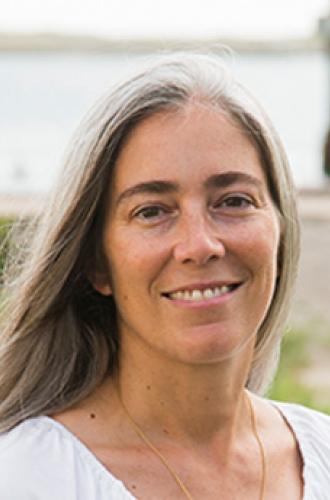-

-

-
Deana L Erdner
Professor
Department of Marine SciencePhytoplankton Molecular Ecology, Harmful Algal Blooms, Interactions Between Algae and Associated Bacteriaderdner@utexas.edu
Phone: 361-749-6719
Office Location
S06
Postal Address
750 CHANNEL VIEW DR
PORT ARANSAS, TX 78373-
Ph.D., Massachusetts Institute of Technology/Woods Hole Oceanographic Institution (1997)
B.S., Carnegie Mellon University (1991)Research Interests
Phytoplankton Ecology
In general, research in my laboratory focuses on the molecular biology and ecology of marine eukaryotic algae, with an emphasis on harmful and/or toxic species, particularly dinoflagellates. This includes basic biological questions as well as more applied studies that try to understand how and why blooms form in nature.Current research topics include:
Genetic diversity, structure, and connectivity of dinoflagellate populations
Processes that drive population structure in planktonic dinoflagellates
Structure and function of dinoflagellate-bacteria associations
Cell death processes in dinoflagellates
-
Selected Publications
Bacosa, H.P., D.L. Erdner, B.E. Rosenheim, P. Shetty, K. Seitz, B.J. Baker and Z. Liu (2018). Hydrocarbon degradation and response of seafloor sediment bacterial community in the Northern Gulf of Mexico to light Louisiana sweet crude oil. ISME J. doi:10.1038/s41396-018-0190-1.
Lozano-Duque, Y., M. Richlen, T.B. Smith, D.M. Anderson, and D.L. Erdner (2018). Development and validation of a PCR-RFLP assay for identification of Gambierdiscus species in the Greater Caribbean region. Journal of Applied Phycology. doi:10.1007.s10811-018-1491-5.
Choi, C.J., M.L. Brosnahan, T.R. Sehein, D.M. Anderson and D.L. Erdner (2017). Insights into the loss factors of phytoplankton blooms: Cell mortality during the decline of Alexandrium blooms. Limnology and Oceanography. doi: 10.1002/lno.10530
Sassenhagen, I. and D.L. Erdner (2017). Microsatellite markers for the dinoflagellate Gambierdiscus caribaeus from high-throughput sequencing data. Journal of Applied Phycology. doi:10.1007/s10811-017-1076-8.
Severin, T., H. Bacosa, A. Sato, and D.L. Erdner (2016). Dynamics of Heterocapsa sp. and the associated attached and free-living bacteria under the influence of dispersed and undispersed crude oil. Letters in Applied Microbiology 63(6):419-425. doi:10.1111/lam.12661.
Bacosa, H.P., K.M. Thyng, S. Plunkett, D.L. Erdner, and Z. Liu (2016). The tarballs on Texas beaches following the 2014 Texas City “Y” spill” Modeling, chemical, and microbiological studies. Marine Pollution Bulletin 109(1):236-244. doi:10.1016/j.marpolbul.2016.05.076.
Bacosa, H.P., D.L. Erdner, and Z. Liu (2015). Natural sunlight shapes crude oil-degrading bacterial communities in northern Gulf of Mexico surface waters. Frontiers in Microbiology 6:1325. doi:10.3389/fmicb.2015.01325.
Jauzein, C., A. Evans, and D. Erdner (2015). The impact of associated bacteria on morphology and physiology of the dinoflagellate Alexandrium tamarense. Harmful Algae 50:65-75. doi:10.1016/j.hal.2015.10.006.
Bacosa, H. D. Erdner, and Z. Liu (2015). Differentiating the roles of photooxidation and biodegradation in the weathering of Light Louisiana Sweet crude oil in surface water from the Deepwater Horizon Site. Marine Pollution Bulletin 95(1):265-272. doi:10.1016/j.marpolbull.2015.04.005.
Jauzein, C. and D.L. Erdner (2013). Stress-related Responses in Alexandrium tamarense Cells Exposed to Environmental Changes. Journal of Eukaryotic Microbiology. doi: 10.1111/jeu.12065 (online version of record published July 19, 2013).
Chan, C.X., M.B. Soares, M.F. Bonaldo, J.H. Wisecaver, J.D. Hackett, D.M. Anderson, D.L. Erdner, and D. Bhattacharya. (2012). Analysis of Alexandrium tamarense (Dinophyceae) genes reveals the complex evolutionary history of a microbial eukaryote. Journal of Phycology 48(5):1130-1142. doi:10.1111/j.1529-8817.2012.01194.x
Smith, C.B. and D.L. Erdner (2011) Saxitoxin δ15N as a species-specific tracer of nitrogen source used for growth by the toxic dinoflagellate Alexandrium tamarense. Marine Ecology Progress Series 443:19-27.
Erdner, D.L., M. Richlen, L.A.R. McCauley, and D.M. Anderson (2011) Diversity and Dynamics of a Widespread Bloom of the Toxic Dinoflagellate Alexandrium fundyense. PLoS ONE 6(7):e22965. Doi:10.1371/journal.pone.0022965.
Moustafa, A., A.N. Evans, D.M. Kulis, J.D. Hackett, D.L. Erdner, D.M. Anderson, and D. Bhattacharya. 2010. Transcriptome Profiling of a Toxic Dinoflagellate Reveals a Gene-Rich Protist and a Potential Impact on Gene Expression Due to Bacterial Presence. PLoS ONE 5(3): e9688. doi:10.1371/journal.pone.0009688.
McCauley, L.A.R., D.L. Erdner, S. Nagai, M. Richlen, and D.M. Anderson. 2009. Biogeographic analysis of the globally distributed harmful algal bloom species Alexandrium minutum (Dinophyceae), based on LSU rRNA and ITS sequences, and microsatellite markers. Journal of Phycology 45(2):454-463.
Erdner, D.L. and D.M. Anderson. 2006. Global transcriptional profiling of the toxic dinoflagellate Alexandrium fundyense using Massively Parallel Signature Sequencing. BMC Genomics 7:88 (11pp.)
Hackett, J.D., D.M. Anderson, D.L. Erdner, and D. Bhattacharya. 2004. Dinoflagellates: A remarkable evolutionary experiment. American Journal of Botany 91:1523-1534.
-








